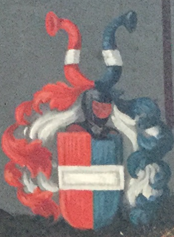
From Frankish Free Imperial Knighthood of Clan Lochner
to Bavarian Nobility of Baron Class since September 6, 1814:
LOCHNER OF HUETTENBACH
The Lochners appear in 1274 with Herman I Lochner, and shortly afterwards around 1290 Boppo Lochner and his presumed sons. His confirmed descendants can only be identified in more detail about 100 years later: Werner I Lochner[1] around 1400, married to Osanna of Wallenfels[2], John I Lochner, who lives on manor Grafendobrach[3] near Bayreuth in 1398, and Conrad I Lochner[4], who takes Kunigunde Rabensteiner of Doehlau[5] as his wife, and is mentioned in Drosendorf in 1399, as a castleman at Neuhaus Castle in the valley of the river Aufsess[6]. This is one of the most powerful „new“ castles that the Dukes of Andechs-Merania have built in Upper Franconia. After 1400 the castle estate of this Lochner line vanishes there[7] (see: 02 HISTORY Lochner in Franconia before 1300).

The top ancestor, Werner I Lochner of Weiher near Hollfeld, of this line has two sons, Conrad II and John IV Lochner. Conrad II Lochner weds Dorothea, from the Hellwagen of Leuzenhof knightly family and they have four daughters together (names not recorded anywhere). As a combative woman, she successfully asserts herself in court in an inheritance case against the Modschiedlers after her husband’s death in 1427. She also negotiates with her brother-in-law John IV Lochner that she could stay in Loch when old[8]. He fathers three sons with Dorothea’s sister-in-law, John IV Lochner’s wife Catherine I Modschiedler. From 1409 he is citizen of Hollfeld[9], where he has owned two estates in Drosendorf upon Aufsess belonging to the a.m. castle of Neuhaus. Between 1419 and 1433, John IV Lochner works as a judge at the Margrave’s court in Kulmbach (district of Bayreuth) – he is also one of the heirs in 1438[10], when Henry III Lochner of Ebermannstadt has died without children.
Of his three sons, besides Michael I Lochner[11], living in Treunitz, and John V Lochner in Hollfeld around 1450, one more son will be of interest now:
it is Conrad III Lochner of Weiher, whose first wife Dorothea comes from the Modschiedler family. No children are born to this marriage (or die in infancy). So he looks for a new woman the second time and enters into wedlock with Barbara of Schlammersdorf. She will give birth to the son and heir Pankraz. His sister Barbara Lochner of Weiher marries Valentin Schenk of Siemau in the Coburg Land on November 13, 1497[12].
Then Pankraz’s father, Conrad III, dies. Now this case will clearly show how close the Lochner relatives are at the end of the 15th century: his class-conscious cousin Henry V Lochner of Waischenfeld takes over the guardianship of the young man and his sister. For the old Waischenfeld Lochner he must have been a glimmer of hope that the old Frankish knightly family would survive in their homeland, because his own sons Leupold, Paul and Philipp are not granted any offspring. Henry, the old Kastner of Waischenfeld (German: Kastner = tithe keeper) and the young, ambitious Pankraz Lochner of Weiher, are present at the first day of knighthood in Franconia in 1501 – and he protects him like his own flesh and blood, because he sets the course for a lucrative marriage with Helena Ermreicher called Tetzel, who descends from his mother’s family. And Henry is certainly partly responsible for Pankraz becoming the (medieval) bailiff for Neideck tithe office (and thus taking a higher position than his relatives, the Lochner of Ebermannstadt, who have stagnated within almost 200 years and remain subordinate reeves – see: 03 LVE HISTORY) and even bailiff of Waischenfeld in 1523 .
With this action, Henry V Lochner of Waischenfeld, the brother of the imperial mercenary captain against the Turks, Conrad (V) Lochner of Liebenfels, has ensured that Pankraz successfully will take over the previous offices of “the blue” lines and so Henry V Lochner of Waischenfeld passes away shortly before the outbreak of the Reformation.
“In 1525, under Bishop Weigand of Redwitz, the Peasants‘ War breaks out in the area of the Bamberg diocese, which has disastrous consequences for Pankraz, as a follower of the bishop, and, of course, for his family. This peasant uprising is primarily directed against Weigand of Redwitz, who did not have his officials and bailiffs collect tithes and other taxes very considerately”[13].
From the Altenburg Castle near Bamberg, where this bishop has holed up with many of his nobles watching the demolition of 98 castles by flames, the Hollfeld inhabitants certainly know that Pankraz has been assigned to the Altenburg to protect the bishop and are taking revenge on his family and his property, because Pankraz has had extensive disputes with his bondmen. But when the bishop forces him to execute the ringleaders after the uprising, Pankraz seems to be fed up. The town of Hollfeld has to pay a sum of 400 florins, Hollfeld office 150 florins and the Waischenfeld people 300 florins. The bishop does not reimburse very much for his castle in Weiher. His Palitz and Waischenfeld relatives have demonstrated to young Pankraz to go new waves: he will come to an agreement with the last Lochners, John VI and Conrad VIII Lochner on Loch about the sale of their ancestral castle area at Loch (remember Kneschke! – see: 03 LVE HISTORY), as already described, accepts the “Lutheran doctrine” (so the Barons Lochner of Huettenbach stay 175 years Lutheran), acquires Winterstein Castle in 1519 and finally the manor in Huettenbach near Simmelsdorf in 1528 (Nuremberg region).
Since 1536 – until today – Pankraz and his descendants have called themselves LOCHNER OF HUETTENBACH. The today’s main line, living near Munich, also have entered into an alliance crest in the 19th century with the extinct Lower Franconian noble family of HEUSSLEIN OF EUSENHEIM on January 19, 1871. A second branch in Elten (on the Dutch border) near Emmerich upon Rhine will die out in the near future.
It is known that his first wife Helena, with whom he has five children, still takes part in the move to Huettenbach, but that certainly horrific experiences in Weiher near Hollfeld affects her so much that she will be dying soon afterwards. She is the first member of the family to be buried in the church on the hill of Buehl near Huettenbach manor.
Pankraz, who, like the niece of his uncle Henry V Lochner of Waischenfeld, Lady High Stewardess Margret Lochner of Liebenfels, must have been born around 1470, and they certainly know each other, wants to start anew after all these troubled times, and he finds Anna Stiebar of Buttenheim as his second wife in 1528. They are blessed with four children. Her cousin Christoph Stiebar from the Regensberg line of the Stiebars (see: 01 PEDIGREE Stiebar of Buttenheim – in progress) acquires the last property of the Waischenfeld Lochners, the cellar house, and is mentioned therefore in the very important document from 1538 with the Liebenfels Lochners of Carinthia (see: 03 LVW / LVL HISTORY).
On July 26, 1546, is the date of death of Pankraz Lochner of Huettenbach. Although he has reached an impressive age by medieval standards, his sons George Gabriel and Andrew are still young, and so will come under the guardianship of their two uncles Achaz and Daniel Stiebar of Buttenheim at Rabeneck, a clergyman of Wuerzburg, the brothers of her mother Anna Stiebar.
Regarding the biography of this man, it should be expressed that he has corresponded with and knew personally the great intellectuals of his time, such as Erasmus of Rotterdam, whom he meets in Basel in 1527 and lives with him in Freiburg in Breisgau in 1529. In Basel (Switzerland) he certainly visits Paracelsus (full name: Philippus Theophrastus Aureolus Bombast of Hohenheim), being the city’s medical doctor there. Daniel Stiebar probably has met Paracelsus again in Nuremberg in 1529, which shows that he is interested in the new type of alchemical medicine. Like many other Catholic clericalists of that time, a letter from Camerarius to Philipp Melanchthon(!) – written in Greek – reveals that Daniel Stiebar has had partnership[14].
His cousin Erhard II Stiebar would have been happy to discuss with Daniel, as he is the father-in-law of Michael Sendivogius Polonius (a Polish aristocrat)[15], who has married his daughter Veronika in 1594. Sendivogius is one of the leading alchemists of his epoch, as well as a philosopher and medical doctor. He is considered a pioneer of chemistry – his writings are widely read and even the world-famous Isaac Newton (1643 – 1727) refers to him. They share the view that experiments in (al)-chem(y)istry are important as evidence[16].
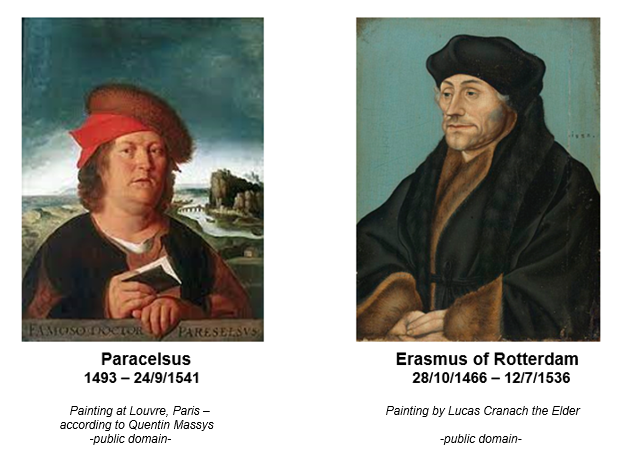

Sendivogius is appointed to the court of Emperor Rudolf II in Prague, where he works alongside Tycho Brahe and John Kepler. The collaboration between the two famous scientists – from March 1600 until the death of Tycho Brahe[17] in October 1601 – was difficult. Kepler, as his successor, becomes imperial court mathematician, astronomer and astrologer – a position he will retain until 1627 (under three emperors)[18]. The most famous radix horoscope that Kepler prepares is for the famous general of the Thirty Years‘ War: Albrecht of Wallenstein.
Another very interesting person that Daniel Stiebar is aquainted with calls himself Doctor John George Faust (1480/81 or 1466 – 1536/39), of whom the great German poet, John Wolfgang of Goethe, will create a monument later on in his play “Dr. Faustus”[19]. So, it is not surprising that Daniel Stiebar is able to provide the best education to the nephews entrusted to his care.
George Gabriel Lochner of Huettenbach, the older of the two brothers, born in 1536, is only 10 years old when his father dies. His guardian arranges for him to study at the University of Erfurt from autumn 1547 – 1549 (i.e. from the age of 11 to 13), even though the system there did not suit well to him, as Joachim Camerarius the Elder has described in one of his numerous letters (here from November 5, 1549) to his uncle Daniel Stiebar. Camerarius, born in Bamberg, is one of the most respected German humanist, philologist, polymath and poet in those days.
He is not only friend with Daniel Stiebar, but also – like Stiebar himself – with Martin Luther’s comrade-in-arms Philipp Melanchthon (see: 02 HISTORY HANS (JOHN) III UNGNAD – in progress). For generations, Camerarius‘ ancestors held the office of “magister camerae” to the bishops of Bamberg. The first, Conrad Liebhard, does so already under Bishop Eberhard II (1146 – 1172), whereupon this family has called themselves “Kammermeister” (German for: chamber masters) and, as as common in the Renaissance, in the Latinized form “Camerarius”[20].
In the same letter, Camerarius announces that he would invite George Gabriel to his house in order to talk to the 13-year-old insistently, because in another letter dated February 2, 1550, he let his uncle Daniel Stiebar know that the little boy is „…negligently raised and cannot be tamed!”. Camerarius also has an extensive discussion with George’s mother, Anna Stiebar, which he greatly regrets, „… because she is of the opinion that city life is to be preferred to country life, but she will never have the intention of putting this into practice“.
There is room to send him to Erfurt to the new Pforta Princely School founded by Duke Maurice of Saxony (Letter: December 18, 1549) – even one of three schools between 1543 and 1550. This is one of the Highest Noble Man of the realm with whom Hans (John) III Ungnad of Weissenwolff, Baron of Sonnegg, is in steady correspondence. This proposed educational institution, now called the Pforta State School, is a boarding high school for the promotion of gifted students that has existed since 1543. Since its founding, the school has used the grounds and buildings of the former Cistercian abbey Pforta in Schulpforte, a district of Naumburg in the Burgenland region in Saxony-Anhalt, after the conversion of monasteries. These schools are the oldest state schools in Germany. In 2018 the a.m. school has celebrated its 475th anniversary[21].
This step has been abandoned and between the ages of 14 and 18, George receives instruction at French universities (1550-1554 – letter: December 18, 1549). Before that, Camerarius places a friend of his with Uncle Stiebar as a new teacher for George and other nephews under Daniel Stiebar’s supervision, including Henry and Erhard Stiebar. The new teacher is none other than Petrus Lotichius Secundus (1528–1560), the most important lyric poet of his time, who is also a professor of medicine in Heidelberg. He has studied this subject in Montpellier in 1551 and in Padua in 1554, graduating in 1556 with a doctorate in Bologna, the oldest university in Europe.
In 1550/51 Lotichius traveled to Paris as a companion of the nephews, including George Gabriel (letter dated April 22, 1551), which has certainly been extremely exciting for a 15-year-old – he got to know the wide world. Daniel Stiebar is now suffering from a bad foot and soon starts a journey to Baden-Baden for a cure in 1554 (letter dated May 27, 1554), where Lotichius and his students visit him for five days.
In a letter dated April 22, 1551, when George Gabriel is 14 years old, Camerarius reports to Uncle Stiebar that the boy has learned from Lotichius (like the other students as well), especially “…to control his stormy temper and his way of life to change” and George would thank Camerarius one day, and “…he appreciates how he composes verses”, which, of course, can be traced back to Lotichius’ influence. Lotichius himself will confirm exactly the same in his letter to Camerarius from July 7, 1551, written from Paris to Leipzig, that “…George and the two other boys (Henry Stiebar of Rabeneck and Conrad Diemar of Walldorf – the other protégés of Daniel Stiebar) have already made small progress in their studies. Even George Gabriel does “pure and sweet verses”. Next time Camerarius will send him a sample. He is confident that he will be able to meet Stiebar’s expectations.
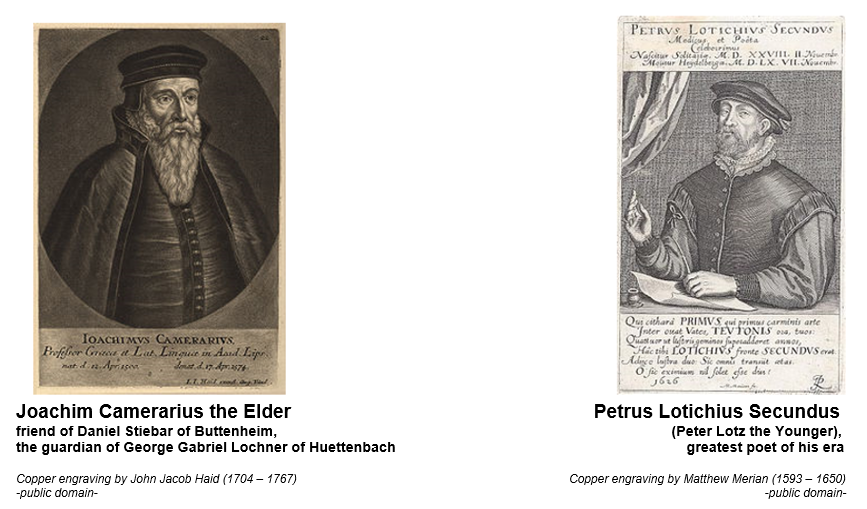
Lotichius also dedicates his little book “Carmina” to Daniel Stiebar of Buttenheim and sends it to Camerarius as a token of his gratitude for the benefits he has received (probably the recommendation to Stiebar). This appreciation of Stiebar by Lotichius can be found again in another letter from Camerarius dated March 15, 1553.
In 1553, George Gabriel Lochner of Huettenbach is now 17 years old, his uncle Daniel Stiebar decides that he should travel to Burgundy, because already on October 6, 1553, the group of students around Lotichius have moved on from Montpellier to Avignon – in April 1554, George began his return journey. His mother sends her own servant to pick up her son. In 1555, George being 19 years old, his uncle Daniel Stiebar extincts – strangely enough, there was no mention of any training for George’s younger brother Andrew in the letters[22].

A few years later, in 1562, George will marry Sybilla Jud of Bruckberg[23], whose coat-of-arms stone from a demolished house in Huettenbach is still conserved. You can clearly see the clothing with a hat that has been prescribed for the Jewish population in the Middle Ages, as the Jud of Bruckberg are converted Jews.
One of her brothers, Wolfgang II Jud of Bruckberg, is a bailiff in Herzogenaurach (the town is today’s headquarter of Adidas and Puma) around 1556 and in a relationship with Anna Gross of Trockau.
This noble family then made a career at the court of the Bavarian Dukes in Landshut, where to this day the wedding of the Bavarian duke and the Polish King’s daughter Hedwig is recreated in the so-called „Landshut wedding“. In memory of this extraordinary event, Thoman Jud of Bruckberg commissions an artistic book that records the events and is intended to glorify them accordingly. The question arises again: from where has Pankraz‘ son got this bride?
In the Landshut area, a Lochner has already married a woman from Lower Bavarian Nobility: Dorothea of Radlkofen. Her knightly family is closely related to the Jud of Bruckberg family. Maybe this mystery about Lower Bavarian relations can be solved at some point… (see: 02 LVW / LVL HISTORY)[24].

George Gabriel Lochner, as the firstborn son, and his wife Sybilla have taken over Huettenbach. In an inheritance contract on September 23, 1598[25], it has been agreed with Andrew and his wife Margret of Wallenrod, who live on Winterstein Castle, that compensation should be paid because Huettenbach is quite larger. So they do, as George has once promised his brother 20 years earlier, but already dies on February 22, 1578.
“At that time, the old manor house in Huettenbach itself was like a kind of “residential tower”, which consisted of four floors “one above the other”, which were accessed in the 16th century via an extra stairway outside that was probably added later. George Gabriel Lochner expanded another tower by including a „stone house“ that was still preserved in the castle courtyard, and it served as a future widow’s residence for his wife (authoress’ note: Sybilla Jud of Bruckberg)”[26].
Andrew Lochner of Huettenbach at Winterstein does not have any noble offspring with his wife Margret of Wallenrod, to whom he is dedicated in „true love and loyalty“[27] – he otherwise claims the children of his brother George Gabriel, namely John George, Wolf Pankraz, will inherit just like Justina and Margret.
This payment settlement mentioned above will be even a bitter pill for George’s grandson Rochus, because when his father John George (March 11, 1563 – 1606, his mother is Eva of Aufsess[28]) dies, he has accumulated such a high sum of debts that the young heir never knows how to pay the momentous agreement in the long term, as even the Thirty Years‘ War has begun. His father’s debts of over 15,000 fl., however, have outstandings of around 10,000 florins in the opposite.
At that time, a farm costs 500 guilders and a mill around 1,000 guilders[29]. Rochus also remembers this in his testament and says that a sum of 9,000 guilders have been able to be paid off before Huettenbach becomes his property in 1624 with a remaining debt of around 6,000 guilders. On Winterstein Castle, however, it can be assumed that the Lochner of Huettenbach are dying out in the male line, because John George’s brother Wolf Pankraz has two daughters from his marriage to Sybilla of Schirnding.
“The Lochners (on Winterstein Castle) had probably neglected the property since the Thirty Years‘ War, so that it was in considerable disrepair at the beginning of the 1660s,” the authors are writing about the condition of the old castle[30], and “… some time after the death of Wolf Pankraz Lochner (1639), who had also been in hock with the Tucher Patrician family of Nuremberg for many years, his daughters Catherine and Maria Magdalena sold the manor with the castle to the creditors in their distress in 1662/64”.
After several attempts, the spouses of the two daughters sold their Winterstein inheritance to the Tucher of Simmelsdorf. An agreement has been reached on March 24, 1664 on 18,735 Rhenish guilders.
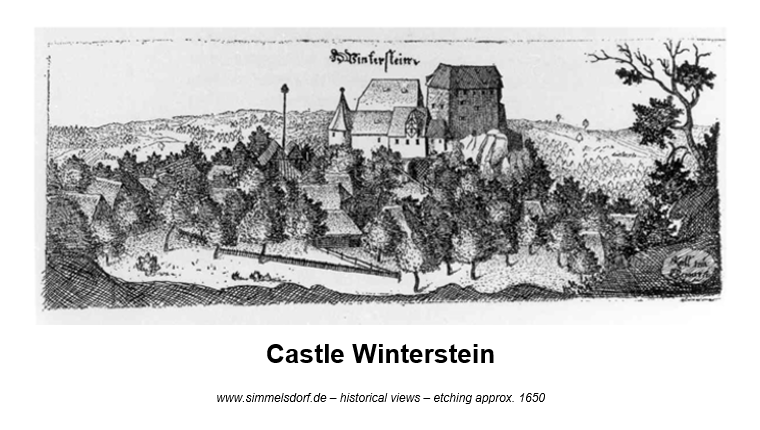
Even while the Thirty Years‘ War (1618 – 1648) is raging, they take legal action against their cousin Rochus because of the lack of compensation and ensure that the benefit of the property in Huettenbach temporarily goes to the plaintiffs („4 years possession of Huettenbach“ and 1,000 guilders compensation payment)[31], finally being determined in Amberg (Upper Palatinate) on November 24, 1669. There is no other explanation why Rochus – visibly angry – expresses in his will the same year that “he has had to wander through cities with his wife and children for 6 years and almost lost everything to the shame and ridicule of his old noble family!” and “…he owes nothing more to that noble man of Portner”[32].
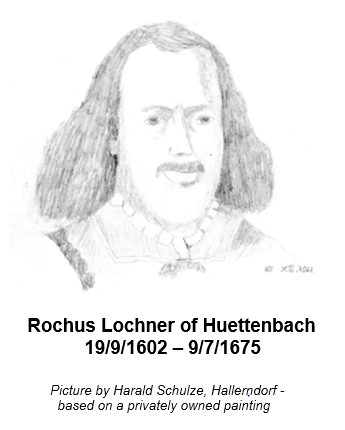
By this, he thinks about John Jacob Portner of Theuern and his wife Justina Catherine Lochner of Huettenbach at Winterstein, who “squeezed the last money out of him” – his brother-in-law, who marries the sister Maria Magdalena Lochner of Huettenbach in 1662, might not have been much better thus “saving” the name of the old knightly family for this line: he is called Adam Lochner of Palitz from Bohemia. His inheritance after the sale of Winterstein amounts to 9,367 fl. rh. He will grandly invest in the purchase of several properties in Upper Palatinate, but since this area belongs to Bavaria, all Protestants are forced to leave the country by 1662 as a result of the Counter-Reformation. In 1691, his five daughters declare to be “unable to pay off each other”. So they ask the government of Upper Palatinate for allowing the sale of the different manors[33].
It should also be noted that miraculously Rochus gave his only daughter to “Mrs. Wedding Planner” and cousin Elisabeth Lochner of Palitz, married Ratiborsky of Sechzebus, and who has fled with her husband to the Margraviate of Bayreuth, despite the bad experience with the Palitz’ Lochners, he agrees to Elisabeth’s son John Wolf could marry Maria Sabina Susanna Lochner of Huettenbach in 1651.
He calls her “the Ratiborskin”[34] in his will. A previous marriage agreement with the noble family of Lentersheim was canceled then.
By a cruel twist of fate, Rochus also has to contend with a lot of war billetings over many years and „…Huettenbach belonged (…) as a Brandenburg fief, even though it was directly in electoral territory, to the enclave of Rothenberg, and the owners (German: Ganerben[35]) there never have in mind to appear at the court in Amberg for taking a fief’s oath because they rightly did not consider themselves to be Bavarian country residents and opposed the Catholicization of their area.
When the Bailiff of the Markgrave of Brandenburg named Varell has protested about the billetings, they fooled (authoress’ note: the Protestant Margrave of) Bayreuth with empty phrases and order to tell Rochus to his face: His subjects must become Catholic, otherwise the soldiers will not be taken away”[36].
His first born George Frederick (1627 – September 4, 1661) from his marriage to Maria Magdalena Stetten of Kocherstetten weds Sophia Magdalena Mendl of Steinfels. His father-in-law has been able to defend his manor Lintach (next to the town of Amberg) in Upper Palatinate for a long time against all hostilities from the Elector of Bavaria. Once a leading figure in the Protestant cause, he dies in March 1653 and Rochus’ eldest son then has paid homage – so re-catholicized – to Elector Maximilian of Bavaria in 1657 to inherit the Upper Palatinate property and immediately afterwards enters the service of the Elector of Bavaria, where he has succumbed to a rampant epidemic during the advance against the Turks in 1661.
As a Protestant, Rochus Lochner is not allowed to take his own grandchildren under guardianship after his daughter-in-law also has passed away three months beforehand, which thwart their re-catholicized relatives in Upper Palatinate. As a result of the disputes between the Protestant Margrave of Bayreuth and the Bavarians, Rochus Lochner finds himself caught between two fronts, because they are trying to blame him for structural damage to Lintach Castle! He emphasizes his belonging to the Frankish Imperial Knighthood and resists all further hostility. Several times he receives support in his difficult life from his rebellious uncle John William[37].
His second son Liborius George Sebastian (January 27, 1639 – November 10, 1683) as a good innings will marry Anna Maria of Aufsess (November 25, 1643 – December 11, 1703), the eldest daughter of this uncle John William of Aufsess at Wuestenstein, who is a convinced Protestant and aware of being member of an ancient Upper Class Frankish family, he fights for his honor and rights in the 30 Years‘ War with all means at his disposal. His own sons – made counts – have absolutely no understanding for him and, certainly to the great chagrin of their aging father, become Catholic – this branch dies out[38].

Liborius George Sebastian, Rochus’ second son, who dies of „podagra“ at the age of 44, and whose illegitimate offspring his father Rochus „grants meager support“ on January 1, 1667, has several children with Anna Maria of Aufsess (four sons and four daughters). He appoints his wife – completely against the custom of that time – as guardian for their sons Christoph Henry (May 22, 1661 – February 20, 1743) and Christoph Louis (October 20, 1677 – August 4, 1760). Liborius expressly writes in his will that the physically disabled sister Sabina Catherine “should not be casted out” (therefore she has lived in the Julian hospital in Wuerzburg)[39].
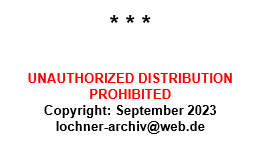
to be continued with:
03 LVH HISTORY 1670 – 1900
FOOTNOTES:
the books mentioned are in German language but the title of the books – as footnotes – are translated for a better understanding
-
Archives of the Counts of Giech at Thurnau, Upper Franconia ↑
-
according to Biedermann (see enclosure: literature) ↑
-
Landbook of Castle Plassenburg, 192, 258 ↑
-
State Archives of Bamberg = StA BA A221/1, no. 1/1, fol. 112 ↑
-
according to Biedermann (see enclosure: literature) ↑
-
StA BA A221/I Nr. 1/I, fol. 5 ↑
-
Hellmut Kunstmann “Castles of Eastern Franconian Switzerland“, commission publishers Ferdinand Schoeningh, Wuerzburg, 1965, p. 139 ↑
-
State Archives of Nuremberg = StA N, Rep. 311 (= document-book of the Barons Lochner of Huettenbach), document no. 3 ↑
-
StA BA A221/I no. 1/I, fol. 68 ↑
-
see enclosure: 03 LVE HISTORY: 1438 – Distribution of the inheritance in Pretzfeld of Reeve Henry III Lochner of Ebermannstadt after his death between all Lochner branches ↑
-
StA BA A205/III L. 752 no. 4221 – Original document in the Archives of the Counts of Giech at Thurnau with the white wax-seal of the Lochner of Weiher ↑
-
StA N, Rep. 311, document no. 19 ↑
-
Citation according to Rudolf Gerstenhoefer: ”Lochner of Huettenbach – from the family’s history of ancient Noble Frankish origin – the Relationship between Upper Palatinate and Franconia”, Lassleben Publishers, Kallmuenz, 1966, p. 57 ↑
-
https://melanchthon.hadw-bw.de/regest.html?reg_nr=5587 – vgl. dazu http://wiki.camerarius.de/OCEp_1053 ↑
-
Rafał T. Prinke: “Michael Sendivogius and Christian Rosenkreutz – The Unexpected Possibilities”, in: The Hermetic Journal, 1990, p. 72 – 98 ↑
-
Ioannes Chorinnus, Illustris[simae] Foeminae D. Dn. Veronicae Stiberiae è Nobiliss[ima] familia apud Francos oriundae, illustris[simi] D. D. Michaelis Christophori Sendivogij de Skorsko & Lukovicze L[iberi] B[aroni] Serenis[simi] Regis Poloniae Secretarij conjugis desideratissimae, quae obijt 23. Octobris, anno
1599. Pragae, Typis Danielis Sedesani. Anno m. DC. IV. – Tract to the death of Veronika Stiebar of Buttenheim, as she dies in Prague on October 23, 1599 because of pestilence ↑
-
Portrait of Tycho Brahe: see 02 HISTORY Ochs of Gunzendorf – in progress ↑
-
Johannes Hemleben: “Johannes Kepler”, Rowohlt Paperback Publishers, 1995 (as an example of the numerous literature to this famous man) ↑
-
Frank Baron: „Doctor Faustus. From History to Legend“, Brill Fink, 1978, p. 393 – (Camerarius‘ letter contents the secret, that Daniel Stiebar is a close friend of Doctor Faust and as far as occult questions are concerned, Faust is his mentor) ↑
-
Gisela Schmitt: „Old and new world. The relationship of Joachim Camerarius to Conquistador Philipp of Hutten“, in: Rainer Koessling – Guenther Wartenberg (editors), Joachim Camerarius, Leipzig Studies to classical Philology IV, Tuebingen, 2003, p. 303 – 335, about Daniel Stiebar p. 325 – 328 ↑
-
https://www.stiftung-schulpforta.de/stiftung-schulpforta/aufgaben/ ↑
-
OPERA CAMERARII – a semantic databank of the printed works of Joachim Camerarius the Elder (1500 – 1574). Editors: Thomas Baier, Joachim Hamm and Ulrich Schlegelmilch. Staff members: Marion Gindhart, Vinzenz Gottlieb, Alexander Hubert, Manuel Huth and Jochen Schultheiß – http://wiki.camerarius.de (since December 20, 2019). – verification oft he immatriculation of George Gabriel Lochner of Huettenbach in autumn 1547 – 1549 at Erfurt University, Thuringia: https://archive.org/details/actendererfurte00erfugoog/page/368/mode/2up?view=theater and
https://resource.database.rag-online.org/ngXN6q274Wv05mtXrW4miVjA ↑
-
StA N, Rep. 311, document no. 44 of the year 1562 ↑
-
Vitus Lechner: “The Noble Family Jud Of Bruckberg, Castle owners from 1432 – 1558“, Raitenhaslach, 2006 –
Peter Kaeser: „Thoman Jud of Bruckberg and the Seybolt-Script for the Landshut Marriage of 1475 – an investigation of the donor picture with the coat-of-arms of the knightly families Jud of Bruckberg and of Radlkofen“, Binabiburg. This report appeared in the 135th volume of the negotiations of the Historical Association for Lower Bavaria, Landshut, 2009, p. 129 – 143 (in 2023 the “Landshut Marriage” was celebrated again after a six-year’s break) ↑ -
State Archives of Nuremberg = StA N, Rep. 311, document no. 77 from the year 1609 ↑
-
Citation: Chapter about „Huettenbach Castle“ on the website www.herrensitze.com ↑
-
StA N, Rep. 311, document no. 58 of 26/2/1581 at Pottenstein in Franconian Switzerland ↑
-
StA N, Rep. 311, document no. 72 of 15/2/1608 ↑
-
Wording on p. 22 from the book: “Huettenbach – the history of a village“ edited by Volker Alberti, Horst Gebhard and Perry Gumann (1st Mayor of Simmelsdorf-Huettenbach) ↑
-
on the website: www.herrensitze.com ↑
-
StA N, Rep. 311, document no. 117 of 24/11/1669 ↑
-
StA N, Rep. 311, document no. 112 from February 1667 ↑
-
Wilhelm Nutzinger: „Neunburg vorm Wald“ (town in Upper Palatinate) – Historical Atlas of Bavaria, part of Old Bavaria, issue 52 – Commission for Bavarian History, Michael Lassleben Publishers, Munich, 1982, p. 210 – 215 ↑
-
StA N, Rep. 311, document no. 97 of 15/6/1651 ↑
-
Ganerben: in Latin “condominium” marks a society of owners, who maintain an object communally – for example – a castle (described on the website: www.historisches-lexikon-bayerns.de) ↑
-
Friedrich Lippert: “History of the Counter-Reformation in the state, church and customs of the Upper Palatinate-Electoral Palatinate at the time of the Thirty Years‘ War“, Paul Waetzel Publishers, Freiburg in Breisgau, 1901 ↑
-
Friedrich Lippert: “History of the Counter-Reformation in the state, church and customs of the Upper Palatinate-Electoral Palatinate at the time of the Thirty Years‘ War“, Paul Waetzel Publishers, Freiburg in Breisgau, 1901 ↑
-
Master‘s thesis of Markus Wilson-Zwilling (Mother: Gabriele of Aufsess): „Imperial Knighthood And Order Of Rule – The Case Of John William Of Aufsess 1616 – 1687“, Regensburg University, 1998 (see: Link-Tipps – about the Barons of Aufsess “Edelfreie/Freiherrn von Aufseß” – website created by Markus Wilson-Zwilling – in German language) ↑
-
Rudolf Gerstenhoefer: ”Lochner of Huettenbach – from the family’s history of ancient Noble Frankish origin – the Relationship between Upper Palatinate and Franconia”, Lassleben Publishers, Kallmuenz, 1966 ↑